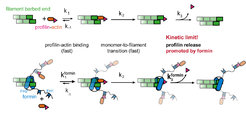Profilin and formin constitute a pacemaker system for robust actin filament growth
Funk J, Merino F, Venkova L, Heydenreich L, Kierfeld J, Vargas P, Raunser S, Piel M, Bieling P (2019). eLife
doi: 10.7554/eLife.50471
In a collaborative work the Bieling group together with the group of Prof Raunser and Mathieu Piel from Institut Curie in Paris reconstituted the assembly of mammalian, non-muscle actin filaments from physiological concentrations of profilin-actin.
They discovered that under these conditions, filament growth is limited by profilin dissociating from the filament end and the speed of elongation becomes insensitive to the concentration of soluble subunits. Profilin release can be directly promoted by formin actin polymerases even at saturating profilin-actin concentrations.

Profilin release controls the speed of actin filament growth. Kinetic scheme of the filament elongation cycle from profilin actin either in the absence (top) or the presence (bottom) of formins. Reaction 1 and 2 are very fast at physiological profilin actin concentrations, which is why reaction 3 (profilin release from the terminal protomer) kinetically limits the elongation cycle. Formins accelerate both the first and third reaction of the cycle.
MPI of Molecular Physiology
